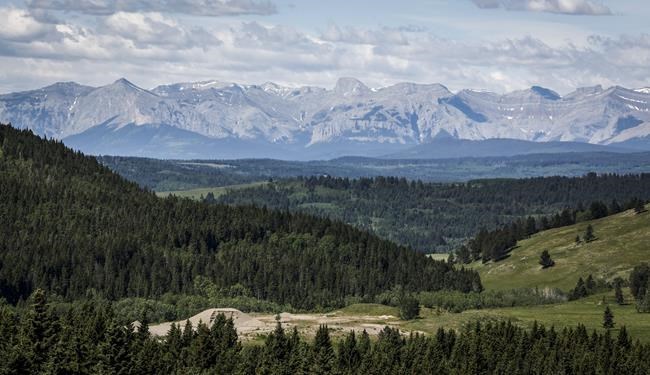
A section of the eastern slopes of the Canadian Rockies is seen west of Cochrane, Alta., Thursday, June 17, 2021. Alberta's utitilies regulator has released a report saying the renewables industry poses little threat to agriculture or the environment. The Alberta Utilities Commission also say there's no consensus on what landscapes should be protected for their scenic value. THE CANADIAN PRESS/Jeff McIntosh
Republished March 13, 2024 - 4:36 PM
Original Publication Date March 13, 2024 - 3:16 PM
EDMONTON - Alberta's utilities regulator has released a report saying the province's booming renewables industry poses little threat to its agriculture or the environment.
"Assuming all renewable development locates on (some of Alberta's best) land, the percentage of (such) agricultural land loss is estimated to be less than one per cent by 2041," says the Alberta Utilities Commission report, released Wednesday.
The commission takes a similar view of concerns that solar and wind facilities could leave landowners and the public with big bills for reclamation at the end of their lives.
"Compared to some other forms of industrial development, renewable power plant projects have well-understood and relatively contained reclamation risks," it says. "The risks associated with groundwater and off-site contamination are generally low."
The report is the first of two the United Conservative government asked the commission to produce as part of its inquiry into the province's booming solar and wind power industry. The release of the report comes shortly after the government removed its six-month moratorium on approvals for new renewables generation.
The current report deals with agricultural and environmental impacts, as well as funding for reclamation and effects on what the government has called "pristine viewscapes."
It found that renewable power is much less of a threat to the province's farmland than other forms of energy development and urban spread.
"From 2019 to 2021, the largest driver of agricultural land loss was expansion of pipelines and industrial sites," it says. "Other key drivers ... include urban residential development, mines and wells, and roads."
The report said the proliferation of wind and solar projects will likely be more concentrated in some parts of the province than others.
The report notes that the vast majority of wind and solar sites are located on poorer land. It also points out that wind farms use about five per cent of their lease area, leaving the rest available for grazing or suitable crops.
It calls for more research on combining agriculture and renewable energy.
The commission concludes that current rules are adequate to ensure reclamation, although there could be more clarity around the point at which developers need to pony up reclamation surety.
"Existing power plant reclamation requirements are sufficiently defined to ensure effective reclamation, but no timing trigger exists to initiate reclamation," it says.
It notes there was wide disagreement about when that financial backstop should be required, in what form it should be provided and who should hold it.
The commission said there's no consensus on what landscapes should be protected for their scenic value.
"It is very difficult to define pristine viewscape in a manner that satisfies all stakeholders, and that doing so may not be desirable because the value of a viewscape is subjective," the report says. "There are circumstances where a view that contains existing development may be of greater value to Albertans than a pristine view."
The commission suggests those concerns could be handled on a case-by-case basis during the application process.
Martin Olszynski, a resource law professor at the University of Calgary, said the report dismantles the government's expressed concerns about the booming growth of renewable power in the province.
"It's an evidence- and reason-based wrecking ball that smashes the government's talking points and policies with respect to renewables," he said.
In February, as it lifted the moratorium on approvals, Premier Danielle Smith's government announced new restrictions on renewables development.
It said it would rule out wind and solar on Alberta's best farmland. It would also impose a 35-kilometre buffer zone around protected areas and so-called "pristine viewscapes" -- a move that some estimate would rule out development over about two-thirds of the province, especially in the south, where wind and sun are strongest.
Others have estimated the restrictions would affect 42 wind and solar projects representing about $11 billion in investment.
Affordability and Utilities Minister Nathan Neudorf was not immediately available for comment.
Olszynski said the commission's approach makes sense. He said the commission seems to be saying most of the tools needed to regulate the industry already exist. Problems can be dealt with as they arise, he said.
"We can be nuanced and thoughtful about it," he said. "If you impose blanket restrictions, as the government seems to want to do, then you can't be nuanced and thoughtful."
This report by The Canadian Press was first published March 13, 2024.
News from © The Canadian Press, 2024